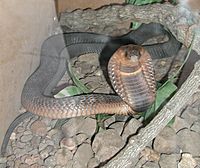Elapid facts for kids
Quick facts for kids Elapidae |
|
|---|---|
 |
|
| Egyptian cobra, Naja haje | |
| Scientific classification | |
| Kingdom: | |
| Phylum: | |
| Subphylum: | |
| Class: | |
| Order: | |
| Suborder: | |
| Family: |
Elapidae
Boie, 1827
|
Elapids are a family of venomous snakes. You can find these snakes in warm, tropical, and subtropical parts of the world. They also live in the Indian Ocean and the Pacific Ocean. Elapids have special hollow fangs that stay fixed in place. These fangs are like tiny needles that inject venom.
Elapids come in many sizes. Some are as small as 18 centimeters (like the Drysdalia). Others, like the King Cobra, can grow up to 6 meters long! Scientists know about 61 different groups (called genera) and 231 types (called species) of elapids.
Contents
What Do Elapids Look Like?
Snakes That Live on Land
Land-dwelling elapids often look similar to colubrid snakes. Most have long, thin bodies with smooth scales. Their heads are covered with large scales and are not always very different from their necks. They also have round pupils in their eyes.
These snakes are usually very active. Most land elapids lay eggs, which means they are egg-laying. However, there are some exceptions. For example, death adders (Acanthophis) are short and thick. They have rough scales and very wide heads. Death adders are also live-bearing and slow-moving. They are predators that wait to ambush their prey.
Some elapid species spend most of their lives in trees or bushes. This is called being arboreal. Examples include the African Pseudohaje and Dendroaspis, and the Australian Hoplocephalus. Many others are good at burrowing underground. These include snakes like Ogmodon and Simoselaps.
Some elapids eat many different kinds of food. Others specialize in eating only certain things. They have adapted to hunt other snakes, lizards, eggs, mammals, birds, frogs, or fish.
Sea Snakes: Life in the Water
Sea snakes are also elapids, but they have changed to live in the ocean. All sea snakes have tails that are shaped like paddles for swimming. They can also get rid of extra salt from their bodies. Most sea snakes have bodies that are well-suited for swimming.
Their belly scales are much smaller than land snakes. Their nostrils are on top of their heads and do not have scales between them. Most sea snakes give birth to live young. They can also breathe through their skin. Studies on the Pelamis platurus show it can get about 20% of its oxygen this way. This helps them stay underwater for longer periods.
The sea kraits (Laticauda sp.) are not as adapted to water life. They spend a lot of time on land and lay their eggs there. They have wide belly scales, and their tails are not as good for swimming. Their nostrils are also separated by scales.
How Elapids Use Venom
Venom for Hunting and Defense
All elapids have a pair of special fangs called proteroglyphous fangs. These fangs are used to inject venom from glands in their upper jaws. The fangs are the first two teeth on each upper jaw bone. They are enlarged and hollow. Usually, only one fang is in place on each side at a time.
When an elapid closes its mouth, the fangs fit into special grooves. In some elapids with very long fangs, like Acanthophis, the fangs can even poke through the skin under their jaw. This does not seem to hurt the snake. The fangs are usually below the front of the eye and point backward. Because of this, most elapids need to bite to inject venom. This action is not as fast as with viper snakes. Vipers can inject venom with just a quick stab.
Some elapids, like Acanthophis and Dendroaspis, have longer fangs. They can make very fast stabbing strikes, similar to vipers. A few species can even spray their venom from the tips of their fangs. They do this as a way to defend themselves. Elapids use their venom both to stop their prey and to protect themselves.
What Makes Elapid Venom Dangerous?
All elapids are venomous, and many can be deadly. Their venoms are mostly neurotoxic. This means they affect the nervous system. Elapid venoms are often considered more dangerous than the venoms of viper snakes. Viper venoms mainly break down tissues.
Famous elapids include the black mamba (Dendroaspis polylepis). Many people think it is the world's most dangerous snake. The fierce snake (Oxyuranus microlepidotus) has the most venomous land snake venom to mice. Hydrophis belcheri, a sea snake, has the most toxic venom of all snakes.
Images for kids
See also
 In Spanish: Elápidos para niños
In Spanish: Elápidos para niños


